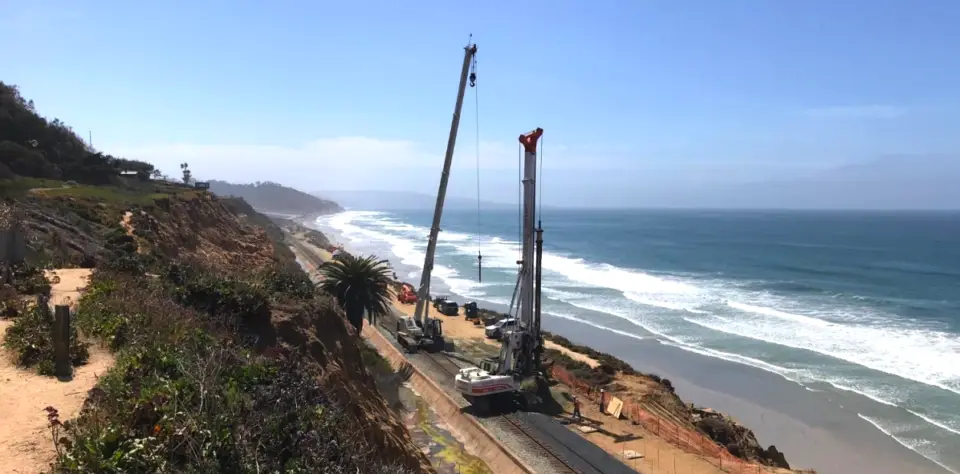DEL MAR — Crews will kick off a three-year, $78 million bluff stabilization project in Del Mar later in March with the goal of protecting the coastal train tracks, improving drainage and preventing bluff failures over the coming decades.
The project, expected to begin March 21, is the fifth of six phases intended to stabilize the bluff through at least 2050. This phase will target a 1.6-mile stretch from Coast Avenue to Torrey Pines State Park, adding around 2,000 feet of seawalls, soldier piles, and tieback anchors to stabilize the track bed and drainage improvements along the bluff.
SANDAG Principal Engineer Allie DeVaux said crews will work on different elements of the project both on the blufftop and down on the beach. They are planning to begin with the construction of some of the seawalls, which run along the toe of the bluff.
Crews will use the Torrey Pines State Beach parking lot and 18th Street lot in Del Mar as beach access areas during the project, according to DeVaux.
“You will see equipment coming through from both these areas and traversing down the beach to get to those areas they need, to construct the seawalls, to construct the drainage outlets, and many of these things,” DeVaux told the Del Mar City Council on March 4.
Construction on top of the bluff will be completed during nighttime windows twice a week so workers can work safely along the tracks.

Despite its anticipated benefit for the rail, many Del Mar residents remain opposed to the project, particularly the seawalls, stating that they will lead to a loss of sand on the beach and greatly impact public safety and access.
On March 4, residents and city leaders said they want to see access improvements implemented either before or at the same time as the seawalls to protect residents.
“The proposed seawalls will block beach access and threaten the safety of surfers and beachgoers if built before vertical access is created, especially at high tide,” said Udo Wahn, a local resident, surfer and vice chair of the San Diego Surfrider Executive Committee.
Under a condition from the California Coastal Commission, SANDAG must complete certain pedestrian access improvements within three years of starting the Phase 5 project. These include an undercrossing at 7th Street to provide access from the bluff to the beach and an enhanced bluff trail between 4th Street and Seagrove Park.
However, city leaders and many residents are now worried about how these improvements will be funded after the SANDAG board of directors agreed last fall to redirect around $14.7 million in dedicated funds toward other regional projects.
Councilmember Terry Gaasterland said a plan for funding these improvements is needed and suggested that seawall construction be delayed in the meantime.
“The [SANDAG] board could continue, theoretically, to not fund the bluff access. We need a way … to push for this to happen,” said Gaasterland.

DeVaux said the schedule for construction is unlikely to change as the contractor chooses it and depends on factors such as which materials can be obtained first.
She assured council members that SANDAG is committed to identifying new funding for the pedestrian access improvements and complying with the three-year timeframe. In the meantime, SANDAG’s current budget of $9 million will fund the preliminary engineering, environmental clearance, and a portion of construction for the project.
“That’s more than enough for us to get through the entirety of design,” DeVaux said. “Our commitment is to get this into construction by Feb. 5, 2027. SANDAG is committed to delivering this project and resolving that funding gap.”
There will also be breaks in the seawalls to preserve current pedestrian access points, she said.
While work is underway on the beach, crews will delineate the areas that are unsafe for the public to access.
DeVaux said residents can expect construction noise, such as equipment backup alarms and drilling to create holes for the piles that will be placed into the bluff. However, she said it will not be nearly as loud as pile driving, which drills the pile itself directly into the earth.
She said there will also be lighting on the bluff during night work that faces west toward the ocean rather than toward homes.
The seawalls and other improvements are ultimately temporary structures intended to provide stability until the train tracks can be moved off the Del Mar bluffs and further inland. All of the infrastructure is required to be removed by 2050.



